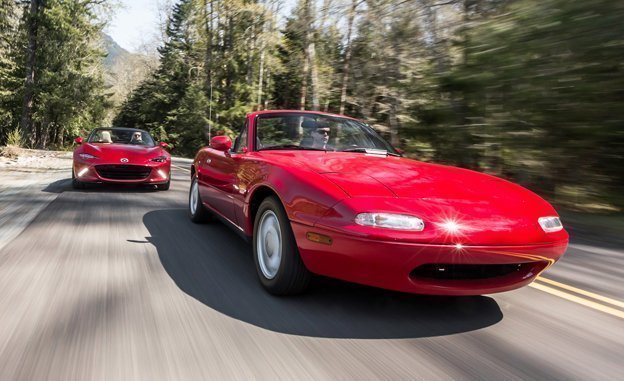Seattle remains at heart a blue-collar port town but with a still-lively tech scene, fostering two distinct communities that blend surprisingly well. It’s a city that’s energetic and urbane while also refreshingly laid-back. But Pike Place Market, the Capitol Hill neighborhood, and the streets of Ballard are distractions, not destinations, in a Miata. And indeed, the city is spending more than $4 billion to bury its cars, replacing the Alaska Way with a two-mile tunnel dug by a calamity-prone machine called Bertha. Get an hour outside of the city, though, and the highways fan out into wisps of asphalt snaking through the Cascades. We chased Carbon River Road into Mount Rainier National Park, where the conifers, ferns, and a blanket of moss filter the high, white sun into a nuclear-green glow.
Our September 1989 road test proclaimed the MX-5 an “honest” sports car—in fact, we used the word 15 times to drive the point home. The cherry specimen photographed on these pages is an honest representation of that honest car. The 1990 model comes from Mazda’s own collection and shows just 4700 miles on the odometer, or 180 miles for every year of its existence. We were privileged enough to add another 180 miles in a single weekend, threading the droptop between vertical stone faces and stone-faced guardrails.
|
|
This 26-year-old veteran drives like a much younger car. The Miata’s nose responds to every millimeter of steering-wheel movement, and the five-speed manual slots into gear with a quick and easy nudge. The four-cylinder engine accelerates with far more spirit than that suggested by the 9.2-second saunter to 60 mph we reported. The chassis is uncertain at the limit, transitioning between understeer and oversteer intermittently and seemingly without preference. But the MX-5 shines at speeds just below where the tires begin to slip, making for a quick pace but not a hurried one.
While the 26-year age gap between old and new Miatas isn’t the same as the chasm between, say, a C2 Corvette and a C7 Z06, there’s no question that the ’90s is an era removed from today’s technology and trends. In 1990, an eight-cylinder Mustang made 225 horsepower, power windows were still optional on most vehicles, and Toyota’s minivan still had its engine between the front seats. Cars were smaller then, yes, but the Miata’s tidy dimensions in 1990 were as intentional as those of the 2016 MX-5 are today. In the original car, the delicate chrome door handles open with a single finger, the cockpit swaddles its passengers, and the manual roof can be flipped back in seconds from the driver’s seat.
|
|
Now, as then, the MX-5 exists in a class of one. In a world of 707-hp Dodge SRT Hellcats, the Miata could be dismissed as minivan-slow (which, today, isn’t all that slow). But with fuel-economy standards marching toward 54.5 mpg, Mazda looks sensible once again. Performance you can use, thrills you can afford.
Relative to the third-generation Miata it replaces, the new car is an evolution measured in fractions of an inch. Each of those nudges moves the new car in the right direction. For improved weight distribution, the engine sits 0.5 inch lower and 0.6 inch farther back. To position the driver closer to the road and the car’s center of gravity, the seats drop 0.8 inch and slide inward by 0.6 inch. The hood plunges 1.1 inches lower, while creased fender peaks help the driver place a tire on a lane marker, at the apex, or half an inch from that fallen rock right there. Graphically, there are surprisingly few references to the happy and harmless faces of Miatas past. The long, sloping nose, the angular headlights, and the broad hips suggest a car that would rather carve than cruise.
|
|
| Bottom right: Even from the rear, the new MX-5 looks more like a serious performance car than does the old car. |
Over the roughest pavement, the MX-5 feels no more rigid than the outgoing model. That’s because Mazda’s focus was on removing weight, not adding structure. Engineers cut fat throughout. The front fenders, all four suspension knuckles, the roll hoops, rear cross-car beam, and both bumper beams are now made of aluminum. The transmission sheds 15 pounds and the differential drops another 22. Inside the seats, mesh netting replaces springs and metal pans. And with less weight to carry around, each wheel hub drops a stud and lug nut (down from five to four), not as a weight-savings measure in itself, but as an indication of how much mass has been eliminated.
Carbon River Road offers our first experience at the wheel of the U.S.-spec 2016 MX-5 powered by a 2.0-liter engine. The Miata’s mill gets its own intake and exhaust manifolds and cylinder head but doesn’t make any more power than the compact-car engine it’s based on. Ratings of 155 horsepower and 148 pound-feet of torque amount to a loss of 12 and a gain of 8, respectively, compared with the outgoing car. What the four-cylinder lacks in raw output, though, it makes up for with enthusiasm. Revs build with a light and quick action that underscores the subjective experience and downplays the numbers. It also makes the flat-four in the Scion FR-S/Subaru BRZ seem downright coarse.
View Photos
View Photos


Leave a Reply